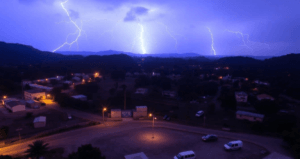ISRO’s 2.5-Hour Lightning Prediction System: A Game-Changer for Public Safety
ISRO has developed a new satellite-based system capable of predicting lightning events in India up to 2.5 hours in advance. Using data from the INSAT-3D satellite, the system tracks lightning signatures by monitoring changes in Outgoing Longwave Radiation (OLR). A drop in OLR strength signals the potential for lightning. To enhance prediction accuracy, ISRO combined this satellite data with other factors like land surface temperature and wind conditions.
The result is a composite variable that helps predict the timing and intensity of lightning activity. This breakthrough provides a reliable lead time, allowing better preparation for lightning hazards. It aims to improve public safety by giving people more time to respond to dangerous weather. This system is a significant step forward in weather forecasting and disaster management in India.

ISRO’s 2.5-Hour Lightning Prediction System: A Game-Changer for Public Safety
Lightning strikes are one of nature’s most unpredictable and deadly phenomena, especially in tropical countries like India. Every year, thousands of people lose their lives or face property damage due to sudden lightning strikes during thunderstorms. Recognizing this critical challenge, the Indian Space Research Organisation (ISRO) has unveiled a revolutionary system capable of predicting lightning events up to 2.5 hours in advance. This groundbreaking technology promises to transform public safety by giving people crucial time to seek shelter and take precautions.
How Does the System Work?
At the heart of this innovation is data from India’s own geostationary satellites, particularly the INSAT-3D, which orbits the Earth in sync with the planet’s rotation. This allows the satellite to remain fixed over India, providing real-time monitoring of weather patterns. The system analyzes Outgoing Longwave Radiation (OLR)—a type of energy emitted by the Earth’s surface and clouds. Scientists observed that a sudden drop in OLR levels often signals the formation of storm clouds, which are likely to produce lightning. Think of it like a “warning sign” from the atmosphere: when OLR dips, it’s a clue that thunderstorms and lightning might be brewing.
But ISRO didn’t stop there. To make predictions even more accurate, the team combined OLR data with other environmental factors:
- Land Surface Temperature: Hotter surfaces can fuel storm intensity.
- Wind Patterns: Shifts in wind speed and direction help identify where storms might develop.
By blending these variables into a single “composite” dataset, the system can pinpoint not just when lightning might strike, but also how intense the event could be. This multi-factor approach reduces false alarms and ensures reliable forecasts.
Why This Matters for India
In tropical regions, lightning is a leading cause of weather-related deaths. Farmers working in open fields, villagers in rural areas, and even urban populations are vulnerable during monsoon seasons. Traditional weather alerts often give only minutes of warning, leaving little time to react. ISRO’s system, however, offers a 2.5-hour head start—a game-changer for disaster preparedness.
For example, authorities can issue early warnings to schools, transportation departments, and outdoor event organizers. Farmers can secure livestock and equipment, while families in high-risk zones can move to safer locations. Over time, this could drastically reduce casualties and economic losses.
The Science Behind the Innovation
The key to the system’s success lies in its ability to detect subtle atmospheric changes. Here’s a simplified breakdown:
- Tracking OLR: The INSAT-3D satellite continuously measures radiation emitted by Earth. Storm clouds, which are dense and tall, trap more heat, causing a noticeable drop in OLR levels. This serves as the first red flag.
- Adding Context: By factoring in land temperature (which influences storm energy) and wind data (which guides storm movement), the system paints a clearer picture of where and how quickly a thunderstorm might escalate.
- Predicting Intensity: Not all lightning strikes are equally dangerous. The composite data helps estimate whether a storm will bring sporadic flashes or a severe, concentrated burst of lightning.
A Step Toward Safer Communities
ISRO’s achievement isn’t just about cutting-edge technology—it’s about saving lives. By leveraging homegrown satellite capabilities, India has joined a small group of nations with advanced lightning prediction systems. The project also highlights the importance of investing in space technology for everyday safety.
Future applications could include integrating these alerts into mobile apps, broadcasting warnings through emergency networks, or even guiding aviation routes to avoid storm-prone areas. For now, the focus remains on refining accuracy and ensuring the system reaches those who need it most, particularly in remote and disaster-prone regions.
In Summary
Lightning prediction has long been a challenge due to its sudden and localized nature. ISRO’s innovative system, powered by satellite data and smart analysis, turns the tide by offering reliable, early warnings. For a country like India, where millions face the threat of lightning yearly, this technology isn’t just progress—it’s protection. By turning raw data into actionable insights, ISRO has once again demonstrated how science can serve society, making everyday life safer for countless people.
This milestone also sets a precedent for other nations to adopt similar strategies, proving that with the right tools, we can outsmart even nature’s most unpredictable hazards.
You must be logged in to post a comment.